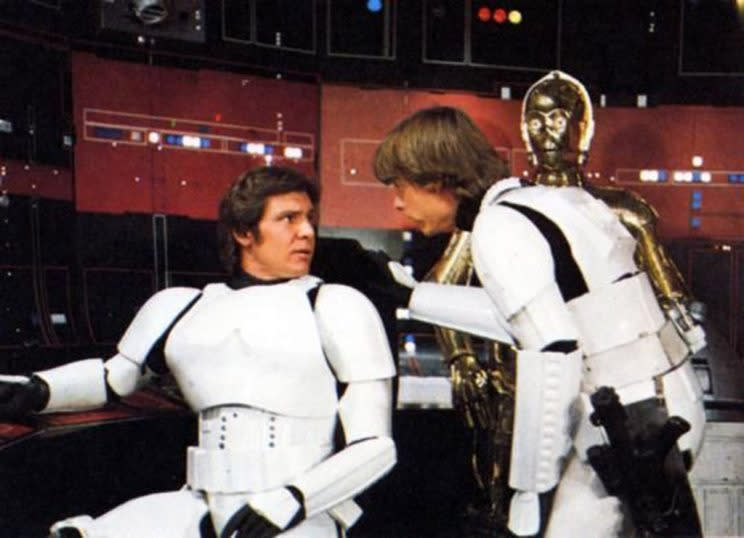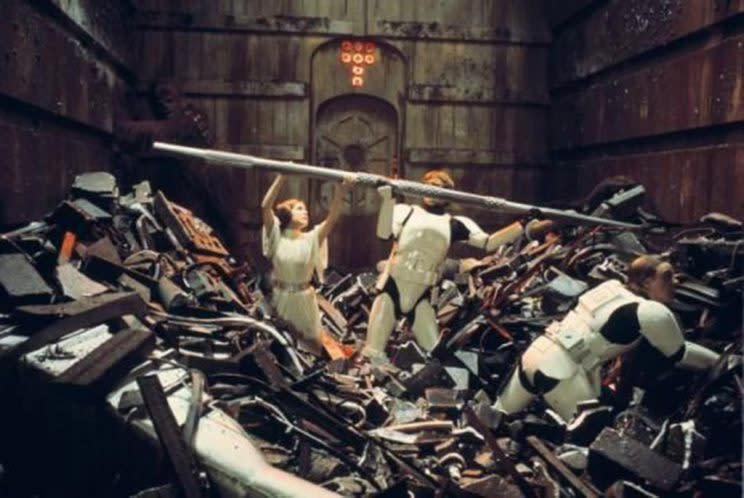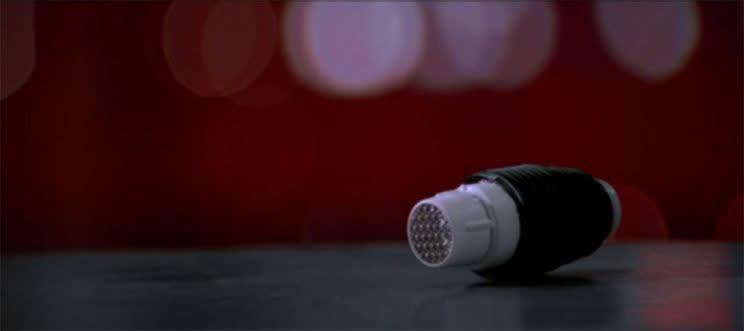'Star Wars' Turns 40: Dirty Secrets From Trash Compactor Scene

Do you sense a disturbance in the Force? Maybe that’s because May 25 is the 40th anniversary of the original release of Star Wars in theaters. To celebrate this auspicious occasion, we’ve been posting Star Wars stories all month, including choice vintage interviews, original videos, and some of our favorite pieces from years past, like this one from 2015. Go here to check out what’s been happening in our galaxy this month.
Set decorator Roger Christian is the man behind such iconic Star Wars designs as the lightsaber, the Millennium Falcon interior, and the R2-D2 prototype. But the Oscar winner says that his toughest job was the trash-compactor scene. One of the oddest, best-loved, and most-nitpicked scenes from the original 1977 Star Wars, the six-minute sequence aboard the first Death Star finds Luke Skywalker (Mark Hamill), Han Solo (Harrison Ford), Princess Leia (Carrie Fisher) and Chewbacca (Peter Mayhew) trapped inside a deadly garbage chamber filled with space sewage, and inhabited by a mysterious tentacled monster called the Dianoga. Based on a 2015 interview with Christian — and drawing from various remembrances of cast and crew members throughout the years — Yahoo Movies took a deep dive into the smelliest scene in the Star Wars galaxy.
Watch the scene:
“Into the garbage chute, flyboy!”
One of the very first people hired by director George Lucas to work on Star Wars, Roger Christian was responsible (along with production designer John Barry) for creating a detailed futuristic world on a minimal budget. “His mantra was always, ‘Everything had to work and look like it worked. Nothing should look designed, nothing should stand out,’” Christian says of the visionary director. And that philosophy extended even to Darth Vader’s garbage.
It was Christian’s job to fill the trash compactor with junk. But he quickly realized that his usual building materials — i.e. the airplane scrap metal he used for the spaceships, or the camera parts he co-opted for lightsabers and binoculars — wouldn’t work.
“I couldn’t use my normal airplane junk, because it would have hurt them, you know?” Christian told Yahoo Movies. “I couldn’t put in anything toxic either, because these are human beings — they’re actors! So I was experimenting with anything. I had to put a huge amount of junk in there, and I was finding rubber bits and different things. [I needed] anything I could see that I knew wouldn’t hurt them, but would look right — rubber hosing, everything.”
“I used a lot of polystyrene. But if it breaks, it’s white inside,” he continued. “So I had the paint shop manage to inject paint into it somehow, so if a piece broke off, it wouldn’t show.”
“What an incredible smell you’ve discovered!”
Christian did his best to make sure that the actors were safe, but shooting the compactor scene was still an ordeal. For one thing, the actors were partially submerged in shallow water for the entirety of the two-day shoot at London’s Pinewood Studios. They wore wet suits under their clothes, which no one seems to remember fondly. “Every time I got wet or, more specifically, too wet, I’d have to get out of this wet rubber outfit to get blown dry,” Hamill said in a 1997 interview. “It was uncomfortable. You’d get rashes in places you never thought possible.” Fisher concurred, telling The Making of Star Wars author J.W. Rinzler, “I liked jumping through the garbage chute, but I didn’t like wearing the wet suit.”
Not only was the cast uncomfortable, but they became increasingly smelly as the shoot went on. In Christian’s words: “Water stinks after a while.” According to Dale Pollack’s Skywalking: The Life and Films of George Lucas, Mayhew was reluctant to enter the water in his furry Chewbacca costume, which unfortunately retained its trash-compactor odor.

“Don’t just stand there — try and brace it with something!”
And then there were the technical challenges. In the scene, the Rebels have escaped from the Stormtroopers, only to discover that the walls of their refuse refuge are literally closing in on them. Christian recalls those walls being pushed in manually by grips because “there were no mechanics in those days to do it, for the money.” Rinzler gives a conflicting account in his book, saying that the walls were rigged. (Either way, the crushing walls were later augmented with mechanical noises, including the sound of a pile driver, by sound designer Ben Burtt, according to his DVD commentary.) Han Solo and Princess Leia try to stop those walls from contracting by bracing them with a long metal pole. Or at least, it looked like a metal pole.
“Harrison had to grab a piece of metal tubing and try to hold the two walls apart. Well, that distance is huge, and I couldn’t get anything light enough,” Christian explains. “So I got drain pipe, which was PVC, and somehow using the joints they had, I managed to get it to a length. But it kept falling apart. So bless Harrison, being such a great human being and such a good actor. I went to him and I said, ‘Harrison, listen — this is all I can do! I’ve been through everything else, and it bends and it wobbles.’ And he made it work — he made it look great. If I’d have had a difficult actor, I would have had a bit of trouble on that.”
“I’ve got a bad feeling about this.”
Ford’s professionalism is all the more admirable considering that his last day of filming was just two days away. The actors and director George Lucas were growing weary after three months of shooting, and they got through the arduous trash-compactor scene by facing it with a sense of humor. Author John Baxter writes in George Lucas: A Biography that in between takes, Ford pretended to chew on the bits of (thankfully non-toxic) rubbish floating around. Hamill made up a song for Lucas about the monster, to the tune of “Chattanooga Choo Choo”: He’d pick up a piece of trash and say, “Pardon me George, could this be Dianoga poo-poo?” (He and Fisher have both repeated this anecdote many times. Lucas, reportedly, was not amused.)
At times, the smell and fatigue did get the best of the actors. Hamill recalls fighting with Ford over the hatch number that Han Solo reads to C-3PO at the end of the scene. (”326-3827!”) Originally, Luke was supposed to say the line, so Hamill had intended to substitute his own phone number and immortalize it on film. However, when the scene was blocked, Ford was closer to the door, so the line was transferred to Han. “Harrison got to say the line, and he started doing his number and that really burned me up,” Hamill told Rinzler. “I said to him, ‘Come on, say mine, I thought of it!’ But he kept doing his own, and I got madder. Finally, Harrison read my number and said, ‘Happy now, you big baby?’ And I laughed, because I felt busted.” (In the finished film, the line is heard over the comlink, so it’s hard to tell who’s saying it — but it sounds like it reverted back to Hamill.)

Hamill had the unique distinction of being the one cast member who was injured in the garbage masher. The minor accident occurred when the Dianoga tentacle appeared to strangle Luke Skywalker, pulling him briefly underwater. Fisher writes in her memoir Wishful Drinking that “during one of the takes, Mark was so intent on making his strangulation look realistic that he ended up bursting a blood vessel in his eye, which in turn left this bright red dot.” Filming on Hamill’s X-wing cockpit scenes had to be delayed as a result, though fans have spotted the burst blood vessel in a few frames of the final version.
“There’s something alive in here.”
As much trouble as the Dianoga gave Hamill, it arguably gave George Lucas even more. The director had big plans for the Death Star’s aquatic menace: It was intended to be “a cross between a jellyfish and an octopus, a transparent muck-monster which can take any shape,” Lucas told Rinzler. Special effects supervisor John Stears created an ambitious design for an inflatable creature powered by air jets. But when they started building, Lucas was dissatisfied. “I kept rejecting things to the point where all we had left was a tentacle,” he admitted. Skywalking notes that Lucas compared that tentacle to “a big, wide, brown turd.”

Perhaps that’s why he made the last-minute decision to add, in post-production, a tentacled eyeball popping out of the water. Visual effects artists Phil Tippet and Jon Berg sculpted the puppet, complete with blinking eye, and filmed it in a miniature replica of the trash compactor (actually, a pool filed with floating debris). “They cut a circle in the floor of the pond, which was up on sawhorses,” Berg told Rinzler. “So I had to sit under there with the stuff leaking all over me, and just jam the puppet up through this thing, turn it around, and put it back down.”
The compromises that George Lucas made with the Dianoga “irritate him to this day,” writes Pollack. But that hasn’t diminished fans’ love for the big-eyed creature, who has been re-constructed by hobbyists (instructions here!); sculpted into teacups and fountains; and drawn into all kinds of fan art. The trash compactor scene as a whole has been dramatized with dogs and Legos, and immortalized as a set of $200 bookends. Fans (including Jon Stewart and a McSweeney’s writer) have endlessly hypothesized over the construction of the Death Star’s garbage mashers, and the mystery of where the monster goes when the walls close in.

“Shut down all the garbage mashers on the detention level!”
There’s another, less well-known mystery to the trash compactor scene: What became of the comlink that C-3PO uses to communicate with Luke Skywalker, thus saving our heroes from the crush of the compactor? Christian described that prop to Yahoo Movies as part of “the missing treasure trove of Star Wars,” because neither Lucasfilm archivists nor diligent fans have located it.
“There was only ever one made, and that’s because George decided while he was shooting to put one into a scene and it wasn’t on the schedule,” Christian said. “I was in John Barry’s office talking with him, and I was showing him some piping from under the sink to go into a set he was trying to design. And the phone rang, and they said, ‘Is Roger there? George needs a comlink now on the set.’ And as he said it, I undid this piece of pipe in a U-bend, and out fell this filter. It dropped in my hand and I went ‘Whoa, look, that’s it! It’s really beautiful!’ And I ran from my office, stuck a ring around it, and ran down to the floor. And that was it. We had one. And that’s talked about still: Where is it?”
Watch Christian talk about designing the first lightsaber:
Read more from Yahoo Movies:
The ‘Star Wars’ Cantina Scene: The Out-of-This-World Story Behind the Galaxy’s Favorite Dive Bar
‘Star Wars’: Our Gruesome Countdown of Every Lost Limb in the Galaxy
“>

